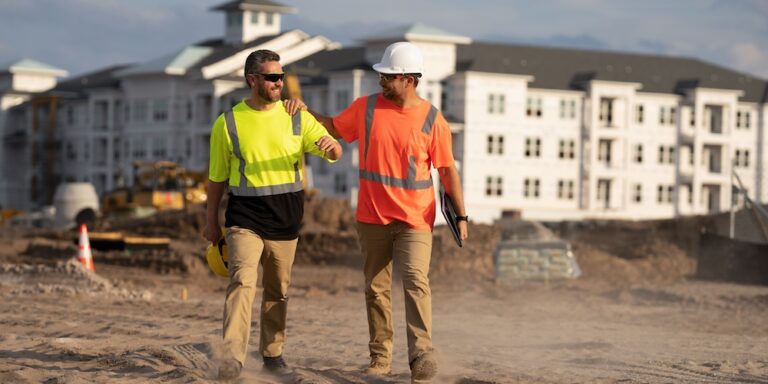— 5 min read
The Importance of Substantial Completion on a Construction Project
Last Updated Jan 15, 2025

Owners want to occupy and use their properties as soon as possible — even though every little detail might not be completed. Agreeing to substantial completion lets them do just that. A certificate of substantial completion also lets the contractor get the last payment and collect retained funds.
Table of contents
Defining Substantial Completion
Substantial completion means the project, or a portion of the project, is fit for its intended use. The owner can then occupy and use the property. There are other important things the date of substantial completion affects:
- The deadline for payments to the general and subcontractors (final payment and retainage)
- A contractor’s deadline to file a mechanics lien or bond claim
- The expiration date for liability and warranties
How is substantial completion determined?
Construction completion is one aspect of construction project management. You can apply substantial completion to a complete project, or to just one part of a project. In both cases, the owner and the contractor sign a certificate of substantial completion.
There will always be minor lingering details to finish up near project completion. At some point, though, these unfinished details don’t prevent the owner from getting some use from the property. Contractors might be waiting on supplies, or for subcontractors to complete minor portions of their work. The owner and the contractor can agree to substantial completion so both parties can focus their energy and resources on other things.
Certificate of Substantial Completion
By this point, the owner and the contractor should know each other well enough to be willing, or not, to sign a substantial completion certificate. Construction projects that use AIA Contract Documents will often use the AIA G704: Certificate of Substantial Completion. In this case, the project's architect will inspect the jobsite and issue the certificate when the site is ready to use.
Owners might resist agreeing to substantial completion if they feel the contractor has not performed well enough. They have concerns about the contractor’s ability or desire to complete the unfinished details. Contractors who have had problems with payments from an owner might not want to sign a certificate of substantial completion. They may fear the owner would drag out payments or worse — not pay. So, there needs to be trust between owner and contractor if they expect to agree to the terms of substantial completion.
Owners have their reasons for wanting a substantial completion certificate. Contractors and subcontractors do as well. Here’s an example:
Suppose a contractor is building an apartment building, and the apartments are finished. However, they haven’t finished the landscaping or the swimming pool. The owner might decide they want to claim substantial completion for just the apartment portion of the contract so they can rent them out and get revenue flowing.
But for the contractor, that means the rest of their work will happen with tenants, management, and salespeople coming and going. That imposes extra risks. Now, they'll need to invest in extra barricades and maintenance to keep people out of work zones, deal with more traffic in parking lots and mitigate risks of damage to their and other people’s vehicles. They'll also have increased risks of bodily injury to bystanders, and risk more damage to the work they're doing.
So, substantial completion requires a negotiation between the owner, the owner’s agent or the architect and the contractor, with each party vying for the best outcomes for themselves.
Stay updated on what’s happening in construction.
Subscribe to Blueprint, Procore’s free construction newsletter, to get content from industry experts delivered straight to your inbox.

AIA Certificate of Substantial Completion Contents
Once the parties agree to the substantial completion definition and terms, they complete a certificate of substantial completion. The top portion names the owner, the owner’s architect and the contractor. Following that, the owner or architect specifies what is substantially completed. They then list the items the contractor must complete or correct including any costs they will pay for the work and when the work will start and finish. The document also specifies who is responsible for “security, maintenance, heat, utilities, damage to the work, insurance,” etc., for the unfinished work.
How a Substantial Completion Form Affects all Parties
A certificate of substantial completion has implications for owners and contractors that they might not realize. Legal counsel can give you perspectives on a per-project basis as to the risks and advantages you accept when signing off on substantial completion. Here are the more common ones.
Creates clear expectations between contractors and clients
Throughout the construction process, there is no substitute for clarity. A well-done substantial completion certificate is very precise in describing the expected outcomes.
Starts Countdown Timer for Other Milestones
Construction completion comes with its own set of milestones that affect everything from claims to warranties. Reaching substantial completion starts a countdown timer for other important milestones, like warranties, Statutes of Limitations and Statutes of Repose. Dates are important — they determine your rights if anything is wrong.
Ensures Prompt Payment
For the contractor, substantial completion means they can collect monies owed for the work they’ve done. They can also collect any retained earnings the owner has been holding.
Reduces Contractor Liabilities
Sometimes, the contractor will have fewer liabilities or project risks to deal with once they have a substantial completion certificate. As pointed out earlier, this depends on the work that’s left to do and whether changes to the site will impose extra expenses or risks. Insurance and bonding coverage are two other factors contractors must consider before agreeing to substantial completion.
Celebrating Project Completion
Reaching substantial completion on a construction project can be an exciting time. The owner can use the property. The contractor can collect payment and retained funds. For both parties, it symbolizes construction completion of a project or portion of a project, and both of them are free to take their next steps.
Was this article helpful?
Thank you for your submission.
91%
9%
You voted that this article was . Was this a mistake? If so, change your vote here.
Scroll less, learn more about construction.
Subscribe to The Blueprint, Procore’s construction newsletter, to get content from industry experts delivered straight to your inbox.
By clicking this button, you agree to our Privacy Notice and Terms of Service.
Categories:
Tags:
Written by
Duane Craig
In addition to his career as a construction project manager/superintendent, Duane has worked as a photojournalist, education director, and landscaper. For the past 14 years, Duane has covered the construction, finance, and tech industries.
View profileExplore more helpful resources

Construction Forecasting Beyond Financials: The Owner’s Guide
Just because a project is large in size, scope or social importance does not mean it will have infinite flexibility and budget. Projects can’t just change their offered service or...

Using Data to Track Subcontractors’ Progress: 5 Keys to Success
Data gives general contractors powerful insights into the progress that subcontractors are — or aren’t —making toward project deadlines. However, the best data isn’t simply there for the taking. Optimizing...

How BIM Software Supports Construction Teams in the Field
Gaps between project design and field execution can cost a lot of money. Architects can create beautiful designs, but if the foreperson and trade crews don’t have access to the...

Mission Critical: Delivering on the Demand for Data Centers
Unprecedented growth in the data center market has created enormous pressure on industry stakeholders to keep pace. The need to quickly build hyperscale data centers to support modern applications demands...
Free Tools
Calculators
Use our calculators to estimate the cost of construction materials for your next project.
Templates
Find a template to help you with your construction project tasks.
Material Price Tracker
Get the latest U.S. retail prices and view historical trends for common building materials.
Glossary
Explore key terms and phrases used in the industry.